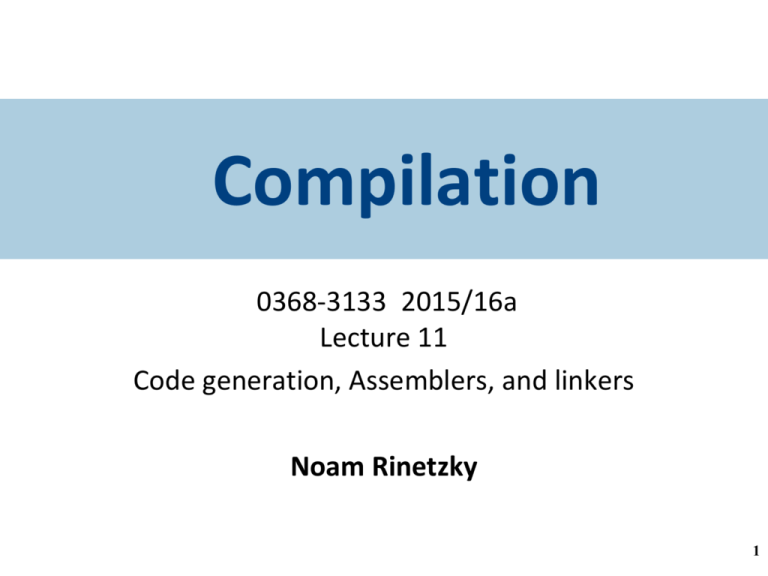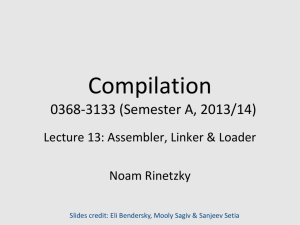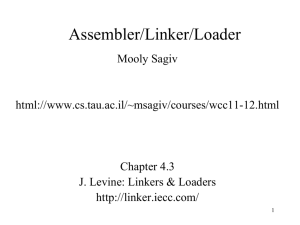PPTX
advertisement

Compilation 0368-3133 2015/16a Lecture 11 Code generation, Assemblers, and linkers Noam Rinetzky 1 Stages of compilation Source code Lexical Analysis Syntax Analysis Context Analysis Portable/Retarg etable code generation Parsing Code Generation Target code (executable) Assembly IR AST + Sym. Tab. AST Token stream Text (program) Simple instructions Load_Mem a, R1 Store_Reg R1, a Add R1, R2 Load_Const cst, R1 … // R1 = a // a = R1 // R2 = R2+1 // R1 = cst 3 Not So Simple instructions Load_Mem a, R1 Store_Reg R1, a Add R1, R2 Load_Const cst, R1 … // R1 = a // a = R1 // R2 = R2+1 // R1 = cst Add_Scaled_Reg c, R1,R2 // R2= r2 + c * R1 4 Not So Simple instructions Load_Mem a, R1 Store_Reg R1, a Add R1, R2 Load_Const cst, R1 … // R1 = a // a = R1 // R2 = R2+1 // R1 = cst Add_Mem a, R1 // R1= a + R1 more efficient than: Load_mem a, R2 Add R2,R1 5 Not So Simple instructions Load_Mem a, R1 Store_Reg R1, a Add R1, R2 Load_Const cst, R1 … // R1 = a // a = R1 // R2 = R2+1 // R1 = cst Add_Scaled_Reg c, R1,R2 more efficient than: // R2= R2 + c * R1 // Artificial instruction Mult_Const c, R1 Add R1,R2 6 Goal Observation: Real machines have hundreds of instructions + different addressing modes Goal: Generate efficient code Use available instructions Input: AST Generated from the parse tree using simple techniques Output: A “more efficient” AST 7 Code Generation Algorithms Top down (maximal munch) Bottom up (dynamic programming) 8 Instruction’s AST: Pattern Tree R result Load_Const cst, R // cost=1 cst constant operand R Load_Mem a, R // cost=3 Add_Mem a, R // cost=3 Add_Scaled_Reg cst, R1, R2 // cost=4 a memory location operand R + R a R1 R1 * cst R2 register operand 9 Instruction’s AST: Pattern Tree #1 R Load_Const cst, R // cost=1 Load_Mem a, R // cost=3 Add_Mem a, R // cost=3 Add_Scaled_Reg cst, R1, R2 // cost=4 cst #2 R a #3 R + R a R1 #7 + R1 * #7.1 cst R2 10 Instruction costs Measures time (cycle) / space (bytes) Models: Fixed, e.g., Load_Constant costs 1 cycles context-defendant e.g., Add_Scaled_Reg c, R1,R2 // R2= R2 + c * R1 11 Example – Naïve rewrite Input tree Naïve Rewrite 13 Top-Down Rewrite Algorithm aka Maximal Munch Based on tiling Start from the root Choose largest tile (covers largest number of nodes) Break ties arbitrarily Continue recursively 14 Top-down largest fit rewrite Input tree TDLF-Rewrite 16 Resulting code Naïve Rewrite TDLF-Rewrite 17 Top-Down Rewrite Algorithm Maximal Munch If for every node there exists a single node tile then the algorithm does not get stuck 18 Challenges How to find all possible rewrites? How do we find most efficient rewrite? And do it efficiently? 19 BURS: Bottom Up Rewriting System How to find all possible rewrites? Solution: Bottom-Up pattern matching How do we find most efficient rewrite? And do it efficiently? Solution: Dynamic Programming 20 BURS: Bottom Up Rewriting System Instruction-collecting Scan Bottom up Identify possible instructions for every node Uses pattern-matching Instruction-selecting Scan top-down selects one (previously-identified) instruction Code-generation Scan bottom-up Generate code (sequence of instructions) 21 Bottom-up Pattern matching “Tree version” of lexical analysis Record at AST node N a label L of a pattern I if it is possible to identify (the part of pattern I rooted at) L at node N #6,#5 #1 #2 22 Labels Instruction leaves result of expression in a location register memory constant The location determines which instructions can take the result as an operand Convention: use labels of the form Llocation e.g., #7reg Location is determined by Label cst means node is a constant 23 Dotted trees Labels can be seen as dotted trees 24 Bottom up pattern matching 25 Bottom up pattern matching 26 Bottom up pattern matching 27 Bottom up pattern matching 28 Example 29 Pattern matching using Tree Automaton Storing the set of patterns explicitly is redundant: Number of patterns is fixed Relation between pattern is know Idea: Create a state machine over sets of patterns Input: States of children + operator of root Output: State of root 30 Pattern matching using Tree Automaton 31 Pattern matching using Tree Automaton In theory, may lead to large autoamton Hundreds of operators Thousands of states Two dimensions In practice, most entries are empty Question: How to handle operators with 1 operand? with many operands? 32 Instruction Selection We can build many trees! Naïve approach: Try them all Select cheapest Problem: Exponential blowup 33 Instruction Selection with Dynamic Programming Cost of sub-tree is sum of The cost of the operator The costs of the operands Idea: Compute the cost while detecting the patterns Label: Label Location @ cost E.g., #5reg @ 3 34 Example cost 1 cost 4 3 4 3 1 6 total cost 8 5 total cost 7 35 Example cost 1 3 cost 4 total cost 12 4 3 1 6 5 total cost 9 36 Example cost 1 cost 4 3 3 1 4 total cost 14 5 6 total cost 13 37 Instruction Selection We can build the cheapest tree • Select label at root based on location of result • Select label at children based on expected location of operands 38 Linearize code Standard ASTCode procedure E.g., create the register-heavy code first 39 Commutativity We got the optimal tree wrt. given patterns Using commutativity Solutions: Add patterns Mark commutative operations and handle them specially 40 Automatic code generators Combining pattern matching with instruction selection leads to great saving Possible if costs are constants Creates a complicated tree automaton 41 Compilation 0368-3133 2014/15a Lecture 11 Assembler, Linker and Loader Noam Rinetzky 42 What is a compiler? “A compiler is a computer program that transforms source code written in a programming language (source language) into another language (target language). The most common reason for wanting to transform source code is to create an executable program.” --Wikipedia Stages of compilation Source code Lexical Analysis Syntax Analysis Context Analysis Portable/Retarg etable code generation Parsing Code Generation Target code (executable) Assembly IR AST + Sym. Tab. AST Token stream Text (program) Compilation Execution Source code Lexical Analysis Syntax Analysis Context Analysis Portable/Retarg etable code generation Parsing Code Generation Executing Target code program (executable) Runtime System image Loader IR Linker Object File Executable File Assembler AST + Sym. Tab. Symbolic Addr AST Token stream Text (program) Program Runtime State Registers 0x11000 foo, extern_foo printf 0x22000 G, extern_G 0x33000 Code Static Data x Stack 0x88000 Heap 0x99000 Challenges goto L2 JMP 0x110FF G:=3 MOV 0x2200F, 0..011 foo() CALL 0x130FF extern_G := 1 MOV 0x2400F, 0..01 extern_foo() CALL 0x140FF printf() CALL 0x150FF 0x11000 foo, extern_foo printf 0x22000 G, extern_G 0x33000 x 0x88000 x:=2 MOV FP+32, 0…010 goto L2 JMP [PC +] 0x000FF 0x99000 Code Static Data Stack Heap Assembly Image Source program Compiler Assembly lang. program (.s) Assembler Machine lang. Module (.o): program (+library) modules Linker “compilation” time Executable (“.exe”): “execution” time Loader Image (in memory): Libraries (.o) (dynamic loading) Outline Assembly Linker / Link editor Loader Static linking Dynamic linking Assembly Image Source file (e.g., utils) Source file (e.g., main) library Compiler Compiler Compiler Assembly (.s) Assembly (.s) Assembly (.s) Assembler Assembler Assembler Object (.o) Object (.o) Linker Executable (“.elf”) Loader Image (in memory): Object (.o) Assembler Converts (symbolic) assembler to binary (object) code Object files contain a combination of machine instructions, data, and information needed to place instructions properly in memory Yet another(simple) compiler One-to one translation Converts constants to machine repr. (30…011) Resolve internal references Records info for code & data relocation Object File Format Header Text Segment Data Segment Relocation Information Symbol Table Debugging Information Header: Admin info + “file map” Text seg.: machine instruction Data seg.: (Initialized) data in machine format Relocation info: instructions and data that depend on absolute addresses Symbol table: “exported” references + unresolved references Handling Internal Addresses Resolving Internal Addresses Two scans of the code Construct a table label address Replace labels with values One scan of the code (Backpatching) Simultaneously construct the table and resolve symbolic addresses Maintains list of unresolved labels Useful beyond assemblers Backpatching Handling External Addresses Record symbol table in “external” table Exported (defined) symbols G, foo() Imported (required) symbols Extern_G, extern_bar(), printf() Relocation bits Mark instructions that depend on absolute (fixed) addresses Instructions using globals, Example External references resolved by the Linker using the relocation info. Example of External Symbol Table Assembler Summary Converts symbolic machine code to binary addl %edx, %ecx 000 0001 11 010 001 = 01 D1 (Hex) Format conversions 3 0x0..011 or 0x000000110…0 Resolves internal addresses Some assemblers support overloading Different opcodes based on types Linker Merges object files to an executable Enables separate compilation Combine memory layouts of object modules Links program calls to library routines printf(), malloc() Relocates instructions by adjusting absolute references Resolves references among files Linker 0 100 200 0 300 450 foo ext_bar() Code Segment 1 Data 100 120 Segment 1 Code Segment 2 400 ext_bar 150 zoo 180 Data Segment 2 0 500 Code Segment 1 Code Segment 2 Data ext_bar zoo 250 280 420 Segment 1 Data 650 Segment 2 380 foo 580 Relocation information • Information needed to change addresses Positions in the code which contains addresses Data Code Two implementations Bitmap Linked-lists External References The code may include references to external names (identifiers) Library calls External data Stored in external symbol table Example of External Symbol Table Example Linker (Summary) Merge several executables Resolve external references Relocate addresses User mode Provided by the operating system But can be specific for the compiler More secure code Better error diagnosis Linker Design Issues Merges Code segments Data segments Relocation bit maps External symbol tables Retain information about static length Real life complications Aggregate initializations Object file formats Large library Efficient search procedures Loader Brings an executable file from disk into memory and starts it running Read executable file’s header to determine the size of text and data segments Create a new address space for the program Copies instructions and data into memory Copies arguments passed to the program on the stack Initializes the machine registers including the stack ptr Jumps to a startup routine that copies the program’s arguments from the stack to registers and calls the program’s main routine Program Loading 0 Registers Code Segment Static Data Stack Heap Loader Image 100 400 500 Code Segment 1 foo Code Segment 2 ext_bar zoo Data 250 280 420 Segment 1 Data 650 Segment 2 Program Executable 580 Loader (Summary) Initializes the runtime state Part of the operating system Privileged mode Does not depend on the programming language “Invisible activation record” Static Linking (Recap) Assembler generates binary code Unresolved addresses Relocatable addresses Linker generates executable code Loader generates runtime states (images) Dynamic Linking Why dynamic linking? Shared libraries Save space Consistency Dynamic loading Load on demand What’s the challenge? Source program Compiler Assembly lang. program (.s) Assembler Machine lang. Module (.o): program (+library) modules Linker “compilation” time Executable (“.exe”): “execution” time Loader Image (in memory): Libraries (.o) (dynamic linking) Position-Independent Code (PIC) Code which does not need to be changed regardless of the address in which it is loaded Enable loading the same object file at different addresses Thus, shared libraries and dynamic loading “Good” instructions for PIC: use relative addresses relative jumps reference to activation records “Bad” instructions for : use fixed addresses Accessing global and static data Procedure calls Where are the library procedures located? How? “All problems in computer science can be solved by another level of indirection" Butler Lampson PIC: The Main Idea Keep the global data in a table Refer to all data relative to the designated register Per-Routine Pointer Table Record for every routine in a table &foo &D.S. 1 &D.S. 2 PT ext_bar &ext_bar &D.S. 2 &zoo &D.S. 2 PT ext_bar foo Per-Routine Pointer Table Record for every routine in a table &foo &D.S. 1 &D.S. 2 PT ext_bar &ext_bar &D.S. 2 foo Code Segment 1 Code Segment 2 foo ext_g ext_bar zoo Data Segment 1 &zoo &D.S. 2 PT ext_bar Data Segment 2 580 Per-Routine Pointer Table Record for every routine in a table Record used as a address to procedure Caller: 1. Load Pointer table address into RP 2. Load Code address from 0(RP) into RC 3. Call via RC RP Callee: 1. RP points to pointer table 2. Table has addresses of pointer table for sub-procedures .func Other data PIC: The Main Idea Keep the global data in a table Refer to all data relative to the designated register Efficiency: use a register to point to the beginning of the table Troublesome in CISC machines ELF-Position Independent Code Executable and Linkable code Format Introduced in Unix System V Observation Executable consists of code followed by data The offset of the data from the beginning of the code is known at compile-time XX0000 Code Segment call L2 L2: Data Segment GOT (Global Offset Table) popl %ebx addl $_GOT[.-..L2], %ebx ELF: Accessing global data ELF: Calling Procedures (before 1st call) ELF: Calling Procedures (after 1st call) PIC benefits and costs Enable loading w/o relocation Share memory locations among processes Data segment may need to be reloaded GOT can be large More runtime overhead More space overhead Shared Libraries Heavily used libraries Significant code space 5-10 Mega for print Significant disk space Significant memory space Can be saved by sharing the same code Enforce consistency But introduces some overhead Can be implemented either with static or dynamic loading Content of ELF file Call PLT Routine PLT GOT GOT Text Libraries Data Data Text Program Consistency How to guarantee that the code/library used the “right” library version Loading Dynamically Linked Programs Start the dynamic linker Find the libraries Initialization Resolve symbols GOT Typically small Library specific initialization Lazy procedure linkage Microsoft Dynamic Libraries (DLL) Similar to ELF Somewhat simpler Require compiler support to address dynamic libraries Programs and DLL are Portable Executable (PE) Each application has it own address Supports lazy bindings Dynamic Linking Approaches Unix/ELF uses a single name space space and MS/PE uses several name spaces ELF executable lists the names of symbols and libraries it needs PE file lists the libraries to import from other libraries ELF is more flexible PE is more efficient Costs of dynamic loading Load time relocation of libraries Load time resolution of libraries and executable Overhead from PIC prolog Overhead from indirect addressing Reserved registers Summary Code generation yields code which is still far from executable Delegate to existing assembler Assembler translates symbolic instructions into binary and creates relocation bits Linker creates executable from several files produced by the assembly Loader creates an image from executable



![Object file formats[edit]](http://s3.studylib.net/store/data/006618103_1-4b9ad58013b9bee33784180bfe3f7f58-300x300.png)




